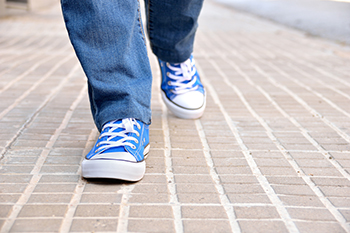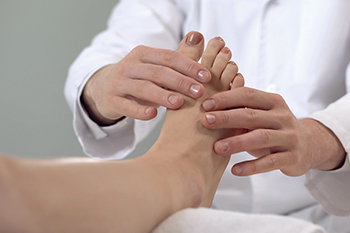Items filtered by date: September 2022
Causes and Effects of Drop Foot

Drop foot is caused by an inability to lift the foot enough to clear the ground as you take a step. It results in a shuffling or dragging type of gait. To counteract that, a person tends to over-lift the knees on each step, resembling a marching gait. Experts find that drop foot is usually a sign that something else is wrong. Causes may be anatomical, muscular, or neurological. Nerve injury, such as damage to the peroneal nerve, is a common cause of drop foot. Symptoms are pain and numbness. It may be brought on by a sports injury, childbirth, or sitting with your legs crossed for a long time. Certain muscle disorders like muscular dystrophy may also be the cause. Electronic imaging tests can be used to detect the underlying cause behind drop foot and treatment options depend on the source of the problem. Many find that custom orthotics, light braces, nerve stimulation, and possible surgery can be helpful. For more information on drop foot and how it may be treated, please consult a podiatrist.
If you have any concerns about your feet, contact Gary Cockrell, DPM from Tennessee. Our doctor can provide the care you need to keep you pain-free and on your feet.
Biomechanics in Podiatry
Podiatric biomechanics is a particular sector of specialty podiatry with licensed practitioners who are trained to diagnose and treat conditions affecting the foot, ankle and lower leg. Biomechanics deals with the forces that act against the body, causing an interference with the biological structures. It focuses on the movement of the ankle, the foot and the forces that interact with them.
A History of Biomechanics
- Biomechanics dates back to the BC era in Egypt where evidence of professional foot care has been recorded.
- In 1974, biomechanics gained a higher profile from the studies of Merton Root, who claimed that by changing or controlling the forces between the ankle and the foot, corrections or conditions could be implemented to gain strength and coordination in the area.
Modern technological improvements are based on past theories and therapeutic processes that provide a better understanding of podiatric concepts for biomechanics. Computers can provide accurate information about the forces and patterns of the feet and lower legs.
Understanding biomechanics of the feet can help improve and eliminate pain, stopping further stress to the foot.
If you have any questions please feel free to contact our offices located in Brentwood and Madison, TN . We offer the newest diagnostic and treatment technologies for all your foot and ankle needs.
Signs and Symptoms of Peripheral Neuropathy

Neuropathy is nerve damage that can arise from varied causes. Peripheral neuropathy is damage to the peripheral nerves, and it often affects the lower extremities. It can be experienced as numbness, tingling, or sharp pains in the feet. One might have trouble maintaining their balance, muscle spasms, or muscle weakness. The affected area may feel hot. If left untreated, this condition can hinder quality of life. Those with diabetes, HIV, stroke, high blood pressure, and autoimmune diseases are among those most at risk for this affliction. Accidents, infections, or vitamin deficiencies can also lead to nerve damage. Smoking and drinking can lead to a higher incidence of peripheral neuropathy as well. Lifestyle changes, such as in diet and exercise, can slow down or reverse symptoms and the progression of such nerve damage. The earlier peripheral neuropathy is caught, the better the diagnosis. So it is suggested that you consult with a podiatrist as soon as symptoms are felt.
Neuropathy
Neuropathy can be a potentially serious condition, especially if it is left undiagnosed. If you have any concerns that you may be experiencing nerve loss in your feet, consult with Gary Cockrell, DPM from Tennessee. Our doctor will assess your condition and provide you with quality foot and ankle treatment for neuropathy.
What Is Neuropathy?
Neuropathy is a condition that leads to damage to the nerves in the body. Peripheral neuropathy, or neuropathy that affects your peripheral nervous system, usually occurs in the feet. Neuropathy can be triggered by a number of different causes. Such causes include diabetes, infections, cancers, disorders, and toxic substances.
Symptoms of Neuropathy Include:
- Numbness
- Sensation loss
- Prickling and tingling sensations
- Throbbing, freezing, burning pains
- Muscle weakness
Those with diabetes are at serious risk due to being unable to feel an ulcer on their feet. Diabetics usually also suffer from poor blood circulation. This can lead to the wound not healing, infections occurring, and the limb may have to be amputated.
Treatment
To treat neuropathy in the foot, podiatrists will first diagnose the cause of the neuropathy. Figuring out the underlying cause of the neuropathy will allow the podiatrist to prescribe the best treatment, whether it be caused by diabetes, toxic substance exposure, infection, etc. If the nerve has not died, then it’s possible that sensation may be able to return to the foot.
Pain medication may be issued for pain. Electrical nerve stimulation can be used to stimulate nerves. If the neuropathy is caused from pressure on the nerves, then surgery may be necessary.
If you have any questions, please feel free to contact our offices located in Brentwood and Madison, TN . We offer the newest diagnostic and treatment technologies for all your foot care needs.
Heel Pain Can Be Treated!
Signs Your Child May Have Sever’s Disease

Calcaneal apophysitis is a foot condition that affects young teenagers and children. It is referred to as Sever’s disease, and it targets people in this age group who frequently participate in running and jumping activities. The growth plate in the heel is affected causing severe pain and discomfort and physical activities may have to temporarily be stopped as the healing process occurs. This condition happens as a result of excessive pressure that is placed on the growth plate, where it connects to the Achilles tendon. This tendon connects the calf muscles to the heel bone and can become sore and swollen when the growth plate endures this type of stress. You may notice your child limps while walking, or some children find it more comfortable to walk on their toes. There are specific stretches that can be performed which may be helpful in finding mild relief as well as wear shoes that fit correctly. If your child has heel pain, it is suggested that you confer with a podiatrist who can properly diagnose Sever’s disease and offer treatment techniques.
Sever's disease often occurs in children and teens. If your child is experiencing foot or ankle pain, see Gary Cockrell, DPM from Tennessee. Our doctor can treat your child’s foot and ankle needs.
Sever’s Disease
Sever’s disease is also known as calcaneal apophysitis, which is a medical condition that causes heel pain I none or both feet. The disease is known to affect children between the ages of 8 and 14.
Sever’s disease occurs when part of the child’s heel known as the growth plate (calcaneal epiphysis) is attached to the Achilles tendon. This area can suffer injury when the muscles and tendons of the growing foot do not keep pace with bone growth. Therefore, the constant pain which one experiences at the back of the heel will make the child unable to put any weight on the heel. The child is then forced to walk on their toes.
Symptoms
Acute pain – Pain associated with Sever’s disease is usually felt in the heel when the child engages in physical activity such as walking, jumping and or running.
Highly active – Children who are very active are among the most susceptible in experiencing Sever’s disease, because of the stress and tension placed on their feet.
If you have any questions, please feel free to contact our offices located in Brentwood and Madison, TN . We offer the newest diagnostic and treatment technologies for all your foot and ankle injuries.
Only Limited Changes to the Running Routine Are Advised

Research has indicated that it is beneficial for people who run to make less than eight changes in their running routine at a time, as this may help to reduce or prevent running injuries. It is important to refrain from increasing speed and mileage too quickly, in addition to wearing correct running shoes. Runners tend to experience more aches and pains in comparison to people who enjoy cycling and swimming. Covid-19 restrictions may have led people to change their running habits from the gym to the road, and the difference in a smooth treadmill versus an uneven street can cause injuries and foot pain. Many experienced runners know the benefits of properly warming up before running, and this can prepare the body for the toll running takes on the feet. It is important to focus on one change to the routine at a time because this can give the body ample time to adjust. If you would like more information about how running can affect the feet, and how to prevent injuries, please confer with a podiatrist who can address any concerns you may have.
All runners should take extra precaution when trying to avoid injury. If you have any concerns about your feet, contact Gary Cockrell, DPM of Tennessee. Our doctor will treat your foot and ankle needs.
How to Prevent Running Injuries
There are a lot of mistakes a runner can make prior to a workout that can induce injury. A lot of athletes tend to overstretch before running, instead of saving those workouts for a post-run routine. Deep lunges and hand-to-toe hamstring pulls should be performed after a workout instead of during a warmup. Another common mistake is jumping into an intense routine before your body is physically prepared for it. You should try to ease your way into long-distance running instead of forcing yourself to rush into it.
More Tips for Preventing Injury
- Incorporate Strength Training into Workouts - This will help improve the body’s overall athleticism
- Improve and Maintain Your Flexibility – Stretching everyday will help improve overall performance
- “Warm Up” Before Running and “Cool Down” Afterward – A warm up of 5-10 minutes helps get rid of lactic acid in the muscles and prevents delayed muscle soreness
- Cross-Training is Crucial
- Wear Proper Running Shoes
- Have a Formal Gait Analysis – Poor biomechanics can easily cause injury
If you have any questions, please feel free to contact our offices located in Brentwood and Madison, TN . We offer the newest diagnostic and treatment technologies for all your foot care needs.

